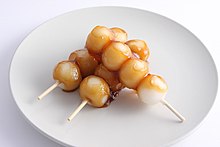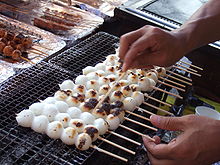Dango


Dango (団子) is a Japanese dumpling made from mochiko (rice flour), related to mochi. It is often served with green tea.
Dango are eaten year-round, but the different varieties are traditionally eaten in given seasons. Three to four dango are often served on a skewer. One variety of dango from Hokkaidō is made from potato flour and baked with shoyu (soy sauce).
Types of dango
There are many different varieties of dango which are usually named after the various seasonings served on or with it. [1]
- Anko: Commonly known as (sweetened) red bean paste, while ingredients other than azuki are used on rare occasions. An-Dango is the most popular flavor in Japan.
- Chadango: Green-tea flavored Dango.[1]
- Bocchan dango: Dango that has three colors. One is colored by red beans, the second by eggs, and the third by green tea.
- Chichi dango: Slightly-sweet light treats usually eaten as a dessert.
- Hanami dango: Also has three colors, Hanami dango is traditionally made during Sakura-viewing season. Hence the name Hanami (Hanami means "flower viewing"; hana meaning "flower", and mi meaning "to see").
- Goma: sesame seeds. It is both sweet and salty.
- Kibi dango: Dango made with millet flour.
- Kinako: A toasted soy flour.
- Kushi dango: Dango held by a skewer
- Mitarashi: Covered with a syrup made from shouyu (soy sauce), sugar and starch.
- Teppanyaki: Dango on a skewer with a tangy teppanyaki taste.
- Sasa dango: Dango that is produced and eaten primarily in Niigata Prefecture. Sasa dango has two varieties: "Onna Dango" and "Otoko Dango." Onna Dango (literally "Female Dango") is filled with anko, while the otoko dango (literally "Male Dango") is filled with kinpira. The dango is wrapped in leaves of sasa for the purpose of preservation.
Derived terms
A common Japanese proverb “Hana yori dango” (花より団子, literally, “dumplings rather than flowers”) refers to a preference for practical things rather than aesthetics.
Dango is used internationally amongst go players as a derogatory term for an inefficient, dumpling-like cluster of stones in a go game. It is also the name of a go variant invented in 1991.
A hairstyle consisting of dango-like buns on either side of the head is sometimes known as odango.
In popular culture
- The cover of Tommy Heavenly6's single "Pray" is designed to appear as a box of Dangos
- One of the minigames in Work Time Fun (WTF) involves sorting dumplings on the dango sticks.
- In Rhythm Heaven (or Rhythm Tengoku Gold), one minigame consists of a monk eating bocchan dango in time with the rhythm of the music.
- In 1999, dango experienced a surge of popularity in Japan following the release of a song entitled "Dango san kyōdai" (three dango brothers). The CD single sold over 2.9 million copies, making it the 4th best selling CD single in Japan during 1968-2006.
- In Otoko wa Tsurai yo, the family of lead character Kuruma Torajirō (Tora-san) operated a small traditional dango shop in Shibamata, Katsushika, Tokyo.
- In Sailor Moon, the protagonist Usagi Tsukino is humorously referred to as odango-atama, "dumpling-head", because of her hairstyle.
- In Clannad, dango are the main focus of the ending theme song, titled "Dango Daikazoku" (literally translated as Great Family of Dango or Big Dango Family). The ending video features personification of many types of dango as they act according to the song. In the series (also in the original visual novel), the main heroine Nagisa Furukawa is very fond of the personifications of dango which she finds to be cute, and likes to sing the beginning of "Dango Daikazoku".
- Hana Yori Dango is also a popular Japanese drama and manga. The title of the series is written 花より男子, which would normally be read hana yori danshi, or 'boys over flowers.' The title forces the reading of 男子 as dango, as a pun on the phrase 花より団子, properly read hana yori dango, meaning 'dumplings over flowers,' or idiomatically substance over style.
- In Zenmai Zamurai, the title character and protagonist has a sword with dango skewered onto it.
- Episode 66 of Gintama is entirely about dango.
- Allen Walker from D.gray-man is quite fond of mitarashi dango
- A character in Naruto is named Anko Mitarashi. She is notoriously fond of dango. Also in the Naruto series, the character Tobi is fond of dango. While walking through the forest with Deidara, Tobi spots a dango restaurant and immediately asks Deidara to stop there. He is seen eating dango and describing everything about the taste.
- In Pikmin 2, a bocchan dango, under the name "Triple Sugar Threat", is found in Level 6 of Snagret Hole.
See also
- Wagashi, traditional Japanese confectionery
